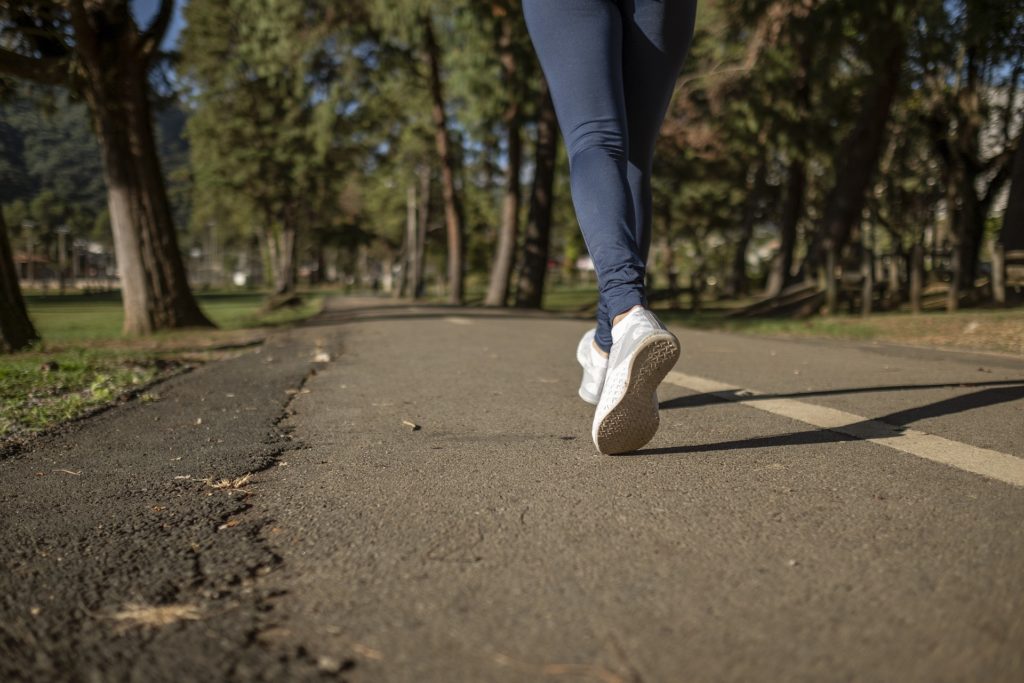In a normal training cycle, long runs and fast workouts will cause soreness. This is a normal part of running – and not something you should completely avoid!

As Steve Magness points out, muscle soreness from a particularly tough workout should be expected and a desired part of the training process. He notes that damage is a good thing because the body “responds by increasing our ability to deal with the stressors, thereby improving our running”. Sounds good to me!
Welcoming muscle damage and being able to run the next day is a balancing act. You need both to improve as a runner, while working to prevent injuries that are all too common for runners.
You want the soreness that makes you adapt to hard workouts and gives you the ability to run consistently. But you also want to put in a high volume of work (meaning, weekly mileage) and stay healthy.
Running after a hard workout when you are sore is important for mental and physical reasons. You may not want to, but running during times of fatigue is beneficial for a variety of reasons.
Embracing Soreness From Hard Workouts or Races

Physiologically, more running can prevent additional soreness in the delayed-onset muscle soreness (DOMS) cycle. The day after a hard workout an easy run will actually make you feel better. PodiumRunner sums this up perfectly:
Exercise itself is analgesic, so on those days when you find your muscles sore from your last workout you will probably actually get some relief from a light recovery session.
The post-hard workout run promotes blood flow to the legs which will aid your recovery. When you couple an easy recovery run with 15-20 minutes of dynamic flexibility exercises or a core routine, you’re increasing recovery even further. More blood flow, no impact forces, and increased mobility help your body get back to neutral.
Easy running when your muscles are sore can also help you psychologically by increasing mental toughness. When I first started running, I often skipped runs when I was sore or if the weather was bad. I learned that it wasn’t helping me become a better runner, so I started getting out the door when conditions weren’t perfect. It has helped me get faster.
Learning to run after a hard workout can help you make running an integral part of your daily routine (even when you feel like crap). Once it’s become a standard behavior, you’ll have difficulty not running.
How to Plan for Hard Workouts

Depending on your goal race, your training plans may look very different with a shifting focus on everything from speed to endurance. Let’s take a look at typical training plans, where the hard workout fits in, and what to do when things don’t go according to plan.
Knowing the answers to these questions will help you determine if you should run after a hard workout.
What is a Hard Run?
In general, “hard” runs are the ones that test your limits and push you into a new realm of running. Structured hard workouts are typically sessions where you are running a series of time- or distance-based repetitions.
A hard run can also be unplanned where you are dealing with weather conditions, lack of sleep, travel, new terrain – or basically anything that make a run feel more challenging than usual. But it’s important to note that this kind of hard run is not a formal “workout” – those have to include structured, faster running.
Planned and unplanned hard runs should be approached similarly in that you focus on movement and recovery afterward.
When To Do a Hard Run?
If you are following a training plan, your long runs are likely scheduled for the weekend. This is for practical reasons – to give you more time to complete the workout. Of course, your time commitments could be different. Maybe you work on weekends or stay with your kids. In that case, you should pick a different day during the week when you can focus on doing the long runs.
7-day cycles in training are standard for most runners. Again, this is for practical reasons, given that most of us have repeating work/school schedules every 7 days. Some professional runners, like Kate Grace, whose job it is to run can play around with the length of training cycles.
“Should I Run After a Hard Workout?”
For all of my runners, I highly recommend doing strength and mobility routines after a hard workout. My favorite options are:
These routine should be done the same day as your hard run, whether immediately after or later in the day.
The day following your hard workout should include some sort of active recovery. This can be an easy run (remember to keep your slow pace slow), cross training, or simply walking.
Exceptions to the Rule
This issue isn’t completely black and white – there are going to be times when you shouldn’t run after a hard workout. Let’s look at three examples:
1. After a very long race.
I wouldn’t recommend running after a marathon or ultramarathon (especially for new runners). The best strategy is to use a zero impact cross training exercise like pool running or cycling to promote blood flow and recovery without the impact. Spend 15-30 minutes at an easy effort to prevent additional soreness.
Movement is important, yes, but additional stress from running isn’t necessary. Doing a race is likely the goal you have been working toward and giving yourself a break after is critical both for physical and mental recovery.
2. If you made a training mistake.
This often happens because you ran longer or went harder than what you your body was ready for. You could risk an injury if you head out for a run when your body needs rest.
Since your aerobic system (heart, lungs, and cells) gets in shape faster than your structural system (bones, tendons, ligaments, muscles), you have to be very careful. You can address this by doing a lot of core and strength exercises.
If you get into this situation of going harder than you were ready for, your body will let you know – listen to it! Pay attention to feelings of lethargy, sudden aches and pains, or a sense that you are getting sick. All of these are red flags that your body is using to inform you that a break is needed. Take it.
3. If you have trouble walking because something is that tight.
If a particular muscle or tendon is very tight, your goal should be to loosen that area without further aggravating it. I don’t recommend static stretching, but instead do a mobility routine plus a strength routine (like the ITB Rehab Routine). Spend a few minutes on a foam roller and cross train on the bike or in the pool for best results.
3 Things NOT to do After a Hard Workout
1. Ice bath
Ice baths have gained popularity and attention recently. You hear them being attributed in all sorts of recovery stories and fitness improvements. However, they haven’t been shown to help with endurance and may act more as a placebo effect anyway.
If you’d like to hear more on the topic of ice baths (and hot showers), I dive into more details in this episode of the Q&A with Coach series.
2. Non-steroidal anti-inflammatory drugs (NSAIDs)
NSAIDs are another common “tool” that runners often hear about. Some people take these pills preventatively for diseases (which is not supported by current research), some athletes take them for reducing inflammation after workouts.
But keep in mind that we want inflammation, as the recovery process is what drives training adaptation and improvement. When muscle fibers are torn (read: sore), our bodies go into recovery mode which yields exactly what we are striving for in training – getting faster and stronger.
If we reduce inflammation through the use of NSAIDs, we aren’t actually shortcutting recovery, we are eliminating the gains of hard training.
3. Couch-potato mode
Running a hard workout is, by definition, hard. We tend to reward ourselves after such types of intense efforts. And hopefully some of that comes from extra sleep for recovery, a focus on healthy nutrition, and mobility support through movement.
However, many people get into couch-potato mode by skipping their next workout and limiting any sort of exercise in general. Being tired from a run isn’t a good reason to lounge on the couch – in fact, it should serve as the ultimate motivator to continue your training.
Our bodies get stronger and our fitness improves in the process of recovering from inflammation. Active recovery is the most constructive way to get the best outcomes from your hard workouts.
Thinking Big Picture About Fatigue
Most of the time, a short run is the best type of recovery. If you have time, take a nap, do some strength routines, and use your foam roller to work out any kinks.
You can safely skip the fancy recovery methods by focusing on the basics. Remember that muscle soreness isn’t something to avoid, but instead, allow your body to recover and get stronger.
Who takes the day off after a hard workout? Have I convinced you to run instead?
